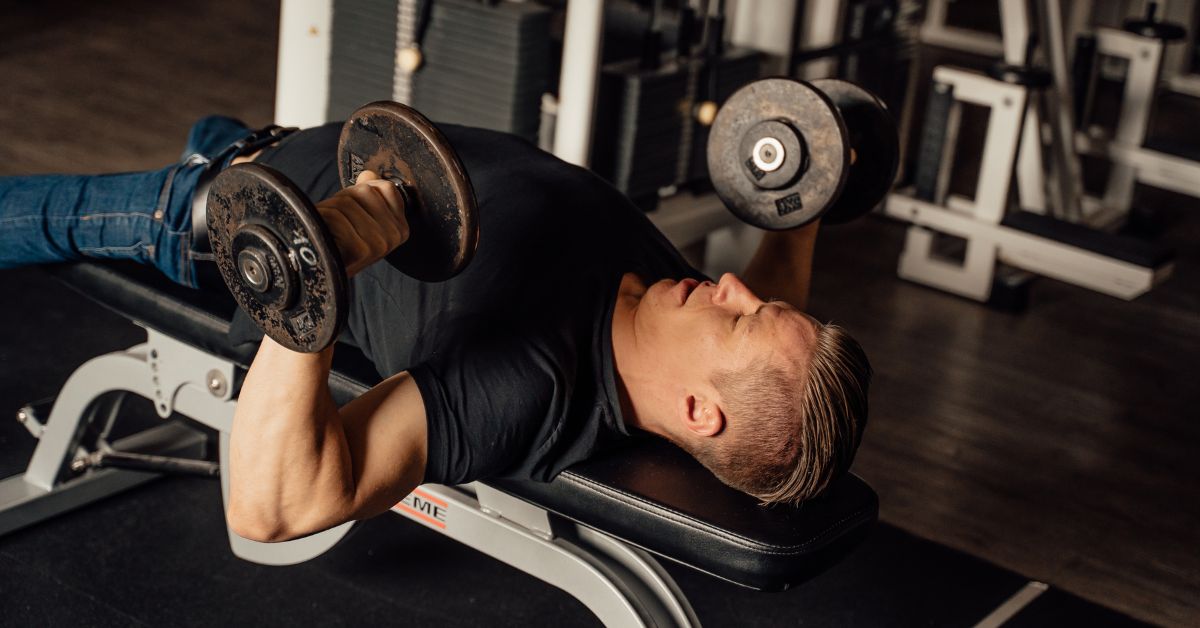
Doing the same workout over and over again can seriously wreck your motivation and progress. It can lead to plateaus, boredom, and even injury.
If your chest and back workouts have been feeling a little stale lately, it might be time to switch things up and add a new number to your routine: the dumbbell pullover.
The dumbbell pullover isn’t a glamorous exercise, but it’s an effective one. It targets the chest, lats (the large muscles on the sides of your back), shoulders, and triceps, making it a great compound move to include in your routine.
Here’s everything you need to know to get the most out of this old-school exercise.
What is a dumbbell pullover?

The dumbbell pullover is a popular strength training exercise in the body-building community, but you don’t need to be a bodybuilder to do it. It’s a weighted exercise that works the chest and back muscles (along with the shoulders and triceps).
“The dumbbell pullover primarily targets the pectoralis major (chest muscles) and the latissimus dorsi (back muscles),” Chris Pruitt, a certified personal trainer and the CEO of WorkoutHealthy, tells The Manual. “Additionally, it engages the triceps, serratus anterior, and core muscles to stabilize the movement.”
To do this exercise, all you need is a dumbbell and enough space to lie down and move your arms overhead.
Dumbbell pullover benefits
“The dumbbell pullover effectively targets both the chest and back, making it a great compound exercise for upper body strength,” says Pruitt. “The required range of motion enhances the flexibility of the shoulders and thoracic spine while maintaining proper form engages the core, helping to improve overall stability and strength.”
Here’s what the dumbbell pullover can do for you:
- The dumbbell pullover engages the triceps and serratus anterior (the “boxer’s muscle” responsible for powerful punches). Regular pullovers can help you develop strength and definition in these areas.
- The exercise’s big arm swing helps loosen up your shoulders, reducing your risk of injury and keeping you in the lifting game longer.
- The dumbbell pullover can be adjusted to fit your fitness level and goals. Start light and gradually increase the weight as you get stronger, or switch up your equipment with barbells or resistance bands to keep things interesting.
How to do a dumbbell pullover

Ready to give it a try? Here’s how to do a dumbbell pullover:
- Lie flat on a bench with your feet planted on the floor, shoulder-width apart.
- Grab a dumbbell with both hands, holding it vertically with your palms facing up.
- Extend your arms straight overhead, keeping a slight bend in your elbows.
- Slowly lower the dumbbell behind your head, keeping your arms straight (but not locked). Keep going until you feel a nice stretch in your chest and lats. Remember to breathe in as you lower and exhale as you lift.
- Pull the dumbbell back up in the same arc motion, squeezing your chest and lats at the top.
- Aim for three to four sets of eight to 12 reps. Start with a lighter weight to get your form right, then gradually increase the weight as you get stronger.
Dumbbell pullover variations
This exercise is pretty straightforward, but there are a few ways you can mix it up to keep your workouts from getting stale:
- Use a barbell instead of a dumbbell. Swap that dumbbell for a barbell and see how much more weight you can handle. Just be sure to grab a friend to spot you, especially when the weights get heavy.
- Use a decline bench. Try doing the pullover on a decline bench. It’ll give your lats and lower chest an even deeper stretch. Note: This one’s not for the faint of heart (or those with high blood pressure).
- Use a medicine ball. If your wrists or elbows are feeling a little tender, a medicine ball is a great alternative. It’s easier on your joints but still gives you a killer workout.
- Lie on the floor. If you’re a beginner (or don’t have a bench), you can do the pullover right on the floor. It’s a good way to get the hang of the movement before graduating to a bench.
The dumbbell pullover is an oldie but goodie. It’s versatile and effective, and if done right, will give you a chest and back that’ll turn heads.
Remember, good form is key to getting the most out of this exercise and avoiding injuries. Start light, focus on slow and controlled movements, and gradually increase the weight as you get stronger. If you’re new to this move, don’t be afraid to ask a trainer for guidance.



